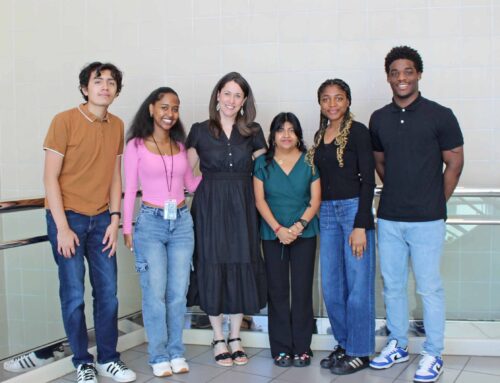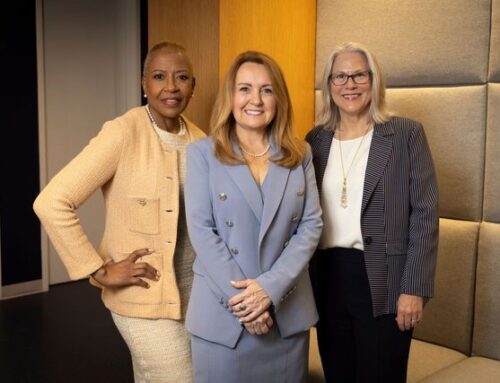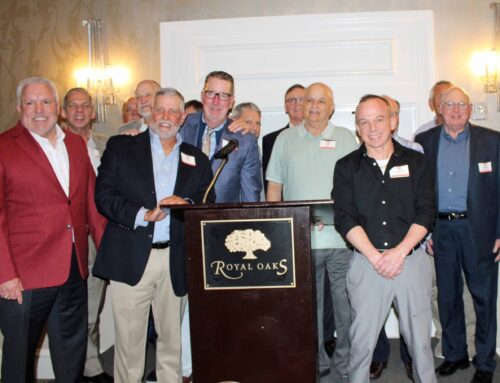Lake Highlands began forming its identity in the mid-1950s, when just about everything north of Northwest Highway consisted of farms and fields. Just south of Northwest Highway, between Easton Road and Buckner, developers were busily subdividing plots to build G.I. housing for young veterans and their families.
Ollie Goldfarb remembers that time with mixed feelings.
“My husband had just gotten out of the Air Force, and we built our home when everything around us was just dirt. I had a toddler, and another baby on the way – and I didn’t know a soul.”
With her family back in Detroit, and her pediatrician’s office closed for the day, Goldfarb was desperate one evening when her newborn suddenly became ill.
“Then I remembered someone saying that the people who had moved into the house catty-cornered to me were a pediatrician and his wife. I bundled up the baby and rushed over there.”
Luckily, Dr. James Ball and his wife, Dorothy, were home that evening with their own young family. Dr. Ball stayed with the Goldfarb baby, which had developed pneumonia, until the crisis was over. By then, the Goldfarbs and Balls had become fast friends.
“Dorothy and I got to talking, and we realized we needed some kind of support group – something to give us more confidence as young mothers. As a pediatrician’s wife, Dorothy had access to professionals who could help us, and that gave us the idea for the preschool PTA.”
By building organizations such as the Lake Highlands Area Early Childhood PTA, neighborhood activists like Goldfarb began a tradition of community service that is carried on by today’s neighborhood leaders.
Here are some of the stories of Lake Highlands residents who helped build the organizations that, with new leaders and supporters, continue to improve our neighborhood.
Strength in Numbers
The group now known as the Lake Highlands Area Early Childhood PTA began with 15 or 20 women, with the common goal of getting to know one another better and learning how to live with preschoolers without “losing our minds,” Goldfarb says.
“I don’t remember modeling it on any other organization,” she says. “We just made it up as we went along.”
At their monthly meetings, they called in early childhood and elementary professionals to speak. They also began volunteering monthly at Parkland’s pediatric unit, putting on programs to entertain the children and enticing celebrities such as Trini Lopez and Mr. Peppermint (Jerry Haynes, also a longtime Lake Highlands resident) to perform.
“I’ll never forget the children we saw there. I don’t think some of them had ever received gifts or had a party before, and they were so excited and grateful each time we came,” Goldfarb says.
“The years I spent with the Early Childhood PTA are more meaningful to me than any other PTA I’ve been involved with,” she says. “For young women just starting out, it gives you a taste of responsibility and leadership.
“It teaches you how to participate in a group, and how to find ways to give back to the community.”
Today, 170 families belong to the Lake Highlands Area Early Childhood PTA. Group president Christine Scott oversees a membership whose needs are more complex than the young suburbanites of the 1950s.
Goldfarb’s generation tended to marry and have children early, making a lifetime career of homemaking and volunteerism. Today’s young mothers often already have had a professional career before starting down the path of the very different, but just as demanding, task of child-rearing.
“I came out of corporate America. I worked long hours and never saw anybody in my neighborhood,” Scott says of her life before children. “After I had my first baby, I didn’t have a support group. All my friends worked and didn’t have kids.”
When a friend told Scott about the PTA, she was willing and eager.
“Initially, I was just interested in the camaraderie – and, of course, in the playgroups that were available,” Scott says. “Unfortunately, young mothers today can’t just throw their kids out in the front yard to play while we clean house, like our mothers did.
“You have to know they’re in a safe environment,” Scott says. “Playgroups meet that need for us.”
With a 2-year-old and an 8-month-old, Scott still manages to devote 30-50 hours a month to the organization as president. In addition to monthly meetings, which continue to have an educational focus, the PTA has developed other programs to meet the needs of the entire family. The PTA sponsors dinner groups, book clubs, walking groups, Dad’s and Mom’s nights out and – most popular of all – a baby-sitting co-op.
For the co-op, each member starts with the same number of tickets. Every time a member baby-sits for someone else in the co-op, he or she earns another ticket.
One of the newest programs involves playgroups organized by elementary school districts.
“That way,” Scott says, “preschoolers will get to know the children they’ll be in kindergarten with. It makes the transition to ‘big school’ a lot easier.”
Members pay $20 annual dues, which help contribute to the J.J. Pearce Scholarship Fund. They also volunteer at the RISD Clothes Closet, which outfits needy students with new and gently used clothing and shoes.
On March 4, the PTA will host its annual auction and fashion show brunch at Royal Oaks Country Club. All funds raised will benefit local elementary school libraries. For information, call Valerie Bissett at 214-343-5141.
A Charitable Exchange
In February 1960, the Lake Highlands Exchange Club held its charter meeting at Vick’s Cafeteria, at the intersection of Ferndale and Northwest Highway.
Vick’s, a longtime neighborhood institution, was a logical choice for meetings back then, as most of the early members were merchants, bankers or Realtors whose businesses clustered around the shopping strips lining the intersection.
A few of the names long-time members recall are Newby’s grocery store, Adams Pharmacy, White Rock State Bank, C&S Hardware and Gingham Girls Dance Studio. The proprietors of these Lake Highlands businesses and others became the core group that formed the charter of the Lake Highlands Exchange Club.
“We wanted to find a way to support the community,” recalls Earl Newby, a retired grocer.
“We started out doing things like honoring a police officer of the month, a firefighter of the month, and things like that to let the police and firefighters know we appreciated them.
“If they needed anything, they would let us know, and we’d find a way to raise the money,” he says. “In fact, the first fund-raising project I remember was to purchase a respirator for the local fire station.”
The Exchange Club also started the practice of honoring outstanding students at the local high school each month and providing scholarship money for deserving seniors, a practice that has continued and expanded through the years.
Today’s Lake Highlands Exchange Club boasts 135 members – the largest Exchange Club in the Dallas area, and one of the largest in the United States. Prevention of child abuse is the organization’s primary focus today.
To that end, the Exchange Club in 1992 found the EXCAP Center, a country-wide operation that takes on cases that can’t officially be handled by Child Protective Services (CPS). CPS workers refer families they have identified as having the potential for problems to parent aides EXCAP has trained to work with families in trouble.
The center also distributes food and clothing as needed. This past Christmas, for instance, the Whole Foods Market at Skillman and Kingsley joined the Exchange Club in sponsoring a Giving Tree to benefit EXCAP Center clients. The Lake Highlands Exchange Club also sponsors a number of neighborhood events, including the annual Fourth of July Parade and Halloween Carnival at Lake Highlands North Recreation Center.
The club’s primary fund-raiser is the yearly benefit auction, which with ticket sales, auction proceeds and corporate gifts, nets $45,000. The auction will be held March 21 at the Sheraton Park Central Hotel. Half of all the money raised benefits scholarship recipients. Last year, the Exchange Club awarded $20,000 of its own money to Lake Highlands seniors, plus an additional $20,000 out of funds the club administers for other individuals and memorial trusts.
Club president Rob Braun, a local insurance agent, was invited to join the Exchange Club by his banker when he opened his business in Lake Highlands in 1985.
“I thought it would be a good way to get to know some of the businessmen and women in the community,” he says. “During my first year, I had the opportunity to sit in on the committee interviewing seniors for scholarships. We were there all day, and every young man and woman who came in was better than the one before.
“You hear so many bad things about today’s youth – I just found it so renewing and invigorating that I’ve never forgotten it.”
Braun was so impressed, in fact, that a few years later when the opportunity arose, he made the decision to move his own young family into the Lake Highlands community.
Pioneer Days
It was 1961 when Barbara Hunt and her family moved to Lake Highlands, right across the street from the new Wallace Elementary School. Those were “pioneer” days for Lake Highlanders – there were only fields north of Church Road, and the school had no indoor plumbing.
The local high school was located at what is now Lake Highlands Junior High, and there was no junior high school.
“The community was small and tight-knit but growing,” Hunt says. “And we had no town center, no civic structure. We were in the Richardson school district, but we were also a part of Dallas. We were ‘in between,’ and we felt like an orphan community.”
“At that time, all the women in the neighborhood went to Biggs Beauty Shop at Plano Road and McCree.” One day, I was talking to an acquaintance, Nell Guest, at the beauty shop, about how we had no real civic group to help out in the community, and I was thinking maybe we should form one.
“She said: Honey, you get it together, and I’ll be there.”
So Barbara Hunt got it together. In November 1968, she invited 10 women to her home for coffee. They all came, and some brought guests. That was the beginning of the Lake Highlands Women’s League.
The handful of energetic women wasted no time making an impact on the community. Their first fund-raiser was held early in 1969, on the opening night of the new Country Dinner Playhouse at the corner of Abrams and LBJ Freeway. The evening of dining and entertainment was a sellout.
“In fact,” Hunt says, laughing, “we oversold by six tickets, and someone had to run home and grab a card table and chairs so the extra guests would have a place to sit!”
Hunt recalls that the evening earned the Women’s League around $700. All proceeds were distributed, as they are today, to worthy causes in the Lake Highlands community.
In the early years, the group established a lending library of artworks at the Audelia Road Public Library, bought a piano for the local recreation center, donated public address systems for several schools, and landscaped Lake Highlands Junior High.
“We started the college scholarship program right away, too,” she says. “We had so much fun doing it all. We never dreamed that it would keep going the way it has.”
Today, many daughters of the original members are carrying on the Women’s League tradition. And most of the early members, though no longer active, have become sustaining members, continuing to support the League with their contributions.
Hunt’s daughter, Karen Coffey, is an active League member.
“When I was growing up, I saw the enthusiasm and the excitement of what they were doing, and I could see how much fun they had,” Coffey says. “I always hoped it would continue long enough for me to do it, too. Although the league is different today, the roots are the same, and the legacy is the same.”
The only criteria for membership in the Lake Highlands Women’s League is the willingness and ability to take one day a year to work at the home tour, and the willingness to spend a certain number of hours each year in community volunteer work.
Current League members number 75, with a waiting list of more than three years for others wanting to join. An indication of how the group’s impact has grown over the years is the number of scholarships the League is able to award: 19 in 1997, the most ever.
All leftover funds go back into the community through aid to elementary and junior high schools.
“Principals and teachers know that if they see a student in dire need of clothing or school supplies or an expensive item such as eyeglasses, they can pick up the phone and call the Women’s League,” Coffey says. “We keep funds just for that purpose.”
Almost 30 years ago, Barbara Hunt and a group of friends saw an opportunity to make a difference in their community.
Says Coffey: “We should be challenged by their example. If we can leave just a little bit of what my mom and those like her did, we’ll be doing well.”





